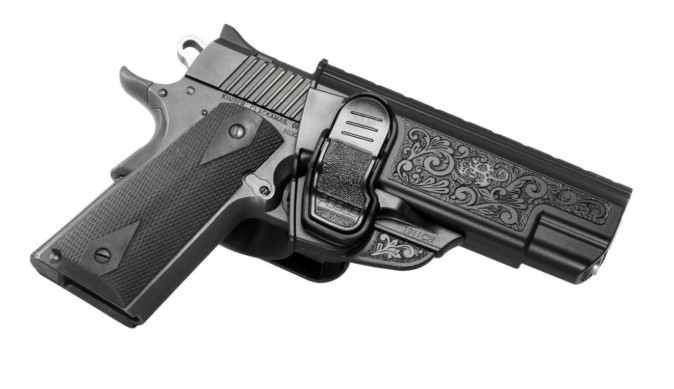The 1911 pistol remains one of the most iconic handguns in history, valued for its reliability, precision, and timeless design. To carry it effectively, finding the right holster for a 1911 is just as important as the firearm itself. Holsters aren’t just accessories—they directly affect comfort, concealment, draw speed, and safety. For many gun owners, the ability to adjust ride height and cant is essential because it allows them to customize how their 1911 sits on the body, ensuring both comfort and quick access.
What Are Ride Height And Cant?
Before making adjustments, it’s important to understand what these two terms mean:
- Ride Height: Refers to how high or low the pistol sits on your waistband. A higher ride height makes the gun easier to conceal, while a lower ride height often improves draw speed.
- Cant: Refers to the angle of the holster in relation to the belt line. A forward cant tilts the grip toward the front of the body for easier drawing, while a straight or neutral cant keeps the firearm upright.
The ability to fine-tune these settings allows users to customize their holster based on body type, clothing, and intended use.
Why Adjustments Matter For A 1911
The 1911 is a full-sized handgun, and without proper holster adjustment, it can feel bulky or awkward to carry. Adjusting ride height and cant ensures that the firearm feels secure and accessible, whether carried openly or concealed. Unlike smaller handguns, the 1911 requires balance—too high, and it may print under clothing; too low, and it may dig into the leg when sitting. A properly adjusted holster improves both everyday comfort and tactical performance.
Step-By-Step Guide To Adjusting Ride Height
Step 1: Identify Adjustment Points
Most modern holsters, including many OWB holster models, come with multiple mounting holes or adjustable clips. These allow users to reposition the holster on their belt line.
Step 2: Test High, Neutral, And Low Rides
- High Ride: Better concealment, but may be slower on the draw.
- Neutral Ride: A balance between concealment and accessibility.
- Low Ride: Fast draw and secure retention, but potentially harder to conceal.
By experimenting with different positions, users can find the balance that best suits their needs.
Step 3: Secure And Test
After adjusting, tighten the screws and test the holster by practicing drawing and reholstering in a safe environment. Small changes can make a big difference in daily comfort.
Step-By-Step Guide To Adjusting Cant
Step 1: Understand The Cant Angles
- Forward Cant (FBI Cant): The grip tilts forward, making the draw easier from behind the hip.
- Neutral Cant: The firearm sits upright, ideal for strong-side carry.
- Negative Cant: The grip tilts backward, which is rare but can be useful for certain cross-draw positions.
Step 2: Adjust Clips Or Mounting Hardware
Many holsters use slotted mounting systems that allow the user to angle the holster as desired. By loosening the screws, repositioning the holster, and re-tightening, you can fine-tune the cant.
Step 3: Practice And Evaluate
The best way to test the cant adjustment is through practice. A slight forward tilt often feels more natural for drawing from the hip, while upright positioning may work better for range use or open carry.
Best Practices For Comfort And Concealment
- Body Type Consideration: Slimmer individuals may prefer a higher ride with a forward cant to reduce printing.
- Clothing Choices: Tighter clothing may require a higher ride for better concealment.
- Purpose of Carry: Everyday concealed carry, range use, or duty carry all call for different holster adjustments.
The flexibility of modern holsters allows 1911 owners to adapt to different scenarios without purchasing multiple holsters.
OWB Holsters Vs. Other Carry Options
While inside-the-waistband (IWB) holsters are popular for deep concealment, an OWB holster remains a favorite among 1911 owners due to its comfort and ease of access. With adjustable ride height and cant, OWB holsters offer a balance between concealment and draw speed. They’re especially practical for open carry, range training, or situations where quick accessibility is a priority.
Common Mistakes To Avoid
- Over-Tightening Screws: This may strip hardware or limit adjustability.
- Ignoring Retention: Adjusting ride height and cant should never compromise firearm security.
- Not Practicing Enough: Changing holster settings requires retraining muscle memory to ensure smooth, safe draws.
Conclusion
A well-fitted holster for 1911 enhances both safety and usability, but achieving the right fit often comes down to adjusting ride height and cant. By experimenting with different positions and angles, 1911 owners can find a setup that provides comfort, concealment, and fast access. Whether using an IWB option or an OWB holster, taking time to make these adjustments ensures the iconic 1911 is carried with both confidence and ease. Proper customization transforms carrying from a daily challenge into a comfortable, secure experience that supports both lifestyle and defense needs.




